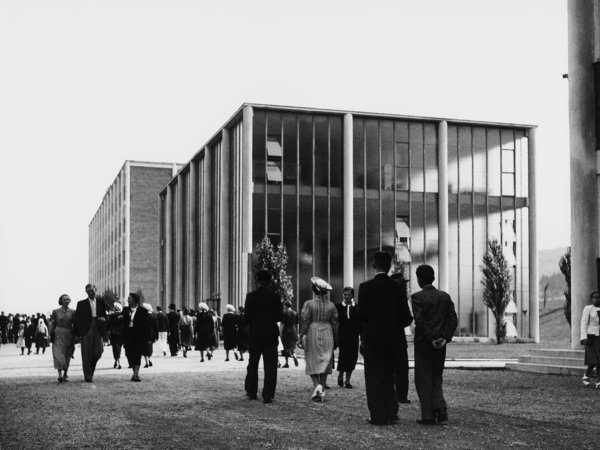Zlin - Model Town of Modernism
dal 17/11/2009 al 20/2/2010
Segnalato da
17/11/2009
Zlin - Model Town of Modernism
Pinakothek der Moderne, Munich
The rise of the small town Zlin in the east of the Czech Republic to the centre of the biggest European shoe manufacturer Bata is a unique economic and social, but also an architectural phenomenon. By means of models, plans, objects, photographs and films the architectural development, the linkage of cultural and social life in Zlin as well as the worldwide circulation of Bata's ideas are presented and critically reflected. A separate area will be dealing with Le Corbusier's planning concepts for Bata. Some of the original drawings of the Fondation Le Corbusier will be shown for the first time.

The rise of the small town Zlín in the east of the Czech Republic to the
centre of the biggest European shoe manufacturer Bat'a is a unique economic
and social, but also an architectural phenomenon. Zlín is a "model town of
Modernism", since many architectural and social ideals that politicians,
entrepreneurs and architects propagated as visionary after World War I, had
been realized there. Thus the town, that Le Corbusier described as a
"shining phenomenon", became a kind of pilgrimage site for all kinds of
proponents of progress in the 1930s.
At the turn of the century, the small
place in which Tomáš Bat'a had founded a shoe factory together with his
brother and sister in 1894, had 3,000 inhabitants, steadily developing to
43,000 by 1938. Thrilled by the ideas and production methods of the most
successful car manufacturer of the time, Henry Ford, and the founder of the
science of management, Frederick W. Taylor, the entrepreneurs Tomáš and Jan
Antonin Bat'a had the small place systematically developed into a kind of
huge laboratory for communal life and work, establishing a system in which
the entire town and all its inhabitants were only serving one single purpose
- the increase of shoe production. Not only the division of labour,
timekeeping and conveyor belts, but also captive social facilities such as
nurseries, schools and a hospital as well as a department store, a sports
club and a large cinema, aimed at this target. Architecture should also
contribute to forming new and better-working people.
The town is divided into zones assigned to the areas of working, living,
spare time and traffic - a separation of functions corresponding to the key
concepts of modern town building that were later propagated in the "Charta
of Athens". Decisively influenced by the architects František L. Gahura and
Vladimír Karfík, almost all public buildings were developed on a planning
grid of 6.15 by 6.15 metres, a uniform measurement which literally served as
a standardization of work and life. Starting out from Zlín, Bat'a had
factories and towns erected in other countries and continents as a smaller
version of Zlín using modern architecture to convey a company-related
identity and modernity.
The exhibition has adapted parts of the Prague show "The Bat'a Phenomenon"
(National Gallery, spring 2009) but has been restructured for Munich. By
means of models, plans, objects, photographs and films the architectural
development, the linkage of cultural and social life in Zlín as well as the
worldwide circulation of Bat'a's ideas are presented and critically
reflected. A separate area, specifically compiled for the Munich show, will
be dealing extensively with Le Corbusier's planning concepts for Bat'a -
which have so far been hardly known, even in expert circles (expansion of
Zlín, a standard plan for the French shoe shops, the French satellite town
Hellocourt and the Bat'a pavilion for the World Fair in Paris in 1937). Some
of the original drawings of the Fondation Le Corbusier will be shown for the
first time. A big model of the World Fair pavilion - only known as a plan so
far - can be experienced in its spatial form for the first time.
There will be two publications by JOVIS Verlag:
"Zlín - Modellstadt der Moderne", edited by Winfried Nerdinger, is an
accompanying catalogue with essays by renowned historians of architecture.
"A Utopia of Modernity : Zlín", edited by Katrin Klingan in cooperation with
Kerstin Gust, is a collection of contributions of international authors on
the phenomenon of Zlín, taking into account the present and future
development of the town.
"Zlín - Modellstadt der Moderne" is part of "Utopie der Moderne : Zlín", a
project of Zipp - German-Czech cultural projects, an initiative of the
Kulturstiftung des Bundes.
Exhibition and catalogue have been compiled in cooperation with the National
Gallery Prague and the Regional Gallery of Fine Arts in Zlín.
ACCOMPANYING PROGRAMME
LECTURE
Thur. 28 Jan. 2010 | 18.00h
Ernst von Siemens-Auditorium at the Pinakothek der Moderne | Barer Straße 40 80333 München
18.00h | Free entrance
In cooperation with the Institut français
Jean-Louis Cohen : Le Corbusier and Bat'a
FILM NIGHT
Thur. 4 Feb. 2010 | 19.00h
Filmmuseum München | St.-Jakobs-Platz 1 | 80331 München
19.00 h | Entrance fee 5 EURO
Zlín - Modellstadt der Moderne
Introduction by: N.N.
LECTURE
Thur. 11 Feb. 2010 or 18 Feb. 2010 | 18.00h
Ernst von Siemens-Auditorium at the Pinakothek der Moderne | Barer Straße 40 80333 München
18.00h | Free entrance
Vladimír Slapeta: Zlín und die osteuropäische Avantgarde
GUIDED TOUR BY CURATORS with Irene Meissner and Susanne Schaubeck
Thur. 26 Nov. 2009 | 18.30h
Thur. 14 Jan. 2010 | 18.30h
Wed. 10 Feb. 2010 | 15.00h
Image: Tomáš Bat’a memorial at the opening of the Institute II, Zlín, 24 April 1938 © KGVUZ-Regional Gallery of Fine Arts in Zlín
For further information and illustration material please contact the press
office of the Architekturmuseum:
Katharina Horn
Presse- und Öffentlichkeitsarbeit
Architekturmuseum der TU München in der Pinakothek der Moderne
horn@lrz.tum.de - http://www.architekturmuseum.de
Press Preview 18 Nov. 2009, 11h
Opening 18 Nov. 2009, 19h
Pinakothek der Moderne
Barer Strasse 40 - Munich



